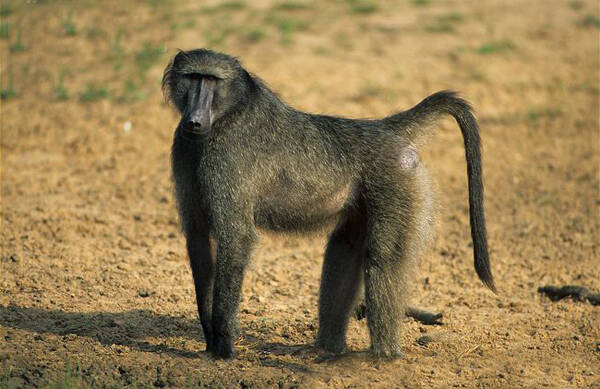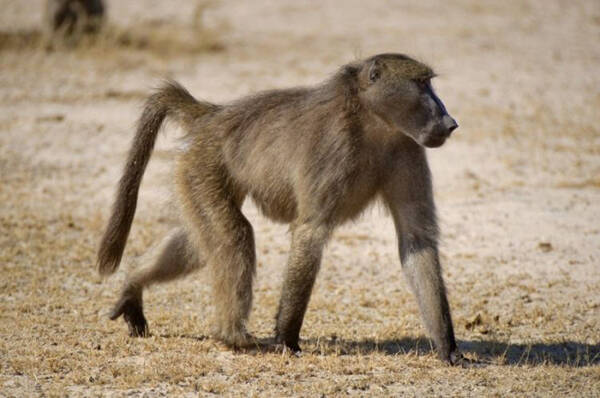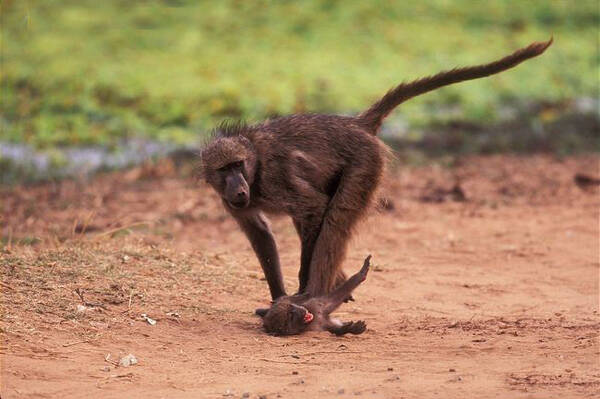Papio ursinus
IUCN
LCBasic Information
Scientific classification
- name:Papio ursinus
- Scientific Name:Papio ursinus,Chacma Baboon
- Outline:Primates
- Family:M.family Baboon
Vital signs
- length:50-114cm
- Weight:15-31g
- lifetime:15-20years
Feature
The skull is large, the face is long, and the face is curved downward.
Distribution and Habitat
Distributed in Angola, Botswana, Lesotho, Mozambique, Namibia, South Africa, Swaziland, Zambia and Zimbabwe.
Inhabits sparse tropical dry grasslands and rocky slopes with sparse trees in semi-desert areas.
Appearance
The Hogtail Baboon is the largest of the baboons. The body length is 508-1,143 mm, the tail length is 456-711 mm; the weight is 15-31 kg, with males weighing 26-31 kg and females averaging around 15 kg. Animals found in the Kalahari Desert are reported to be slightly smaller than average. The average adult brain weight of this species is 214.4 grams.
Males have larger canines, while females have much smaller teeth. There are 32 teeth. The first lower premolar is modified and used as the upper canine. These baboons have a large skull with a long face and a characteristic downward curvature of the face. The top face is narrow and deeply constricted. The skin of the face is dark, purple-black. The tail is curved. The lips are black and the body hair is rough.
The fur on the snout, back, underparts and sides is dark brown to black, and the hands and feet are black. The overall hair color is a single black or single yellow-brown. The hair ends are usually shiny black tips. Males have
Details
Papio ursinus (scientific name: Chacma Baboon) has two subspecies and is the largest baboon.

Papio ursinus is usually active on the ground during the day, is good at climbing rocks, and has the ability to climb trees. Because of its long fur, it is very cold-resistant. It is a social animal that likes to live in groups, sometimes forming large groups of hundreds of individuals, each of which is composed of several families. If there is sufficient food source, the large group will automatically break up and form some stable small groups. Each group occupies a large territory and travels around the territory. Every day, they mostly go out for activities, foraging and drinking along a fixed route, and return to a fixed forest to roost at night. Pig-tailed baboons are wild and often fight in groups. If they encounter an intruder in the territory, the leader often takes the lead and rushes to the front, followed by other members. They are all like fierce and tenacious soldiers, roaring loudly, throwing stones at the intruder, or biting with sharp canine teeth.
In addition to the two hours a day spent eating, the rest of the time is spent grooming each other, combing their hair, and eating lice and other parasites caught at any time, which not only keeps their fur clean, but also serves to connect the emotions between group members. When it is hot, they hide in the shade to rest, play, and perform skills such as dancing and somersaults. At these times, the group will send out "sentinels" to guard around. Whenever wild beasts or birds of prey appear and danger comes, the "sentinels" will make sharp calls to notify their companions to escape or defend against the enemy. This habit makes many other animals often stay near the group of baboons in order to benefit from the signals they send.
A group of baboons can consist of 20 to 80 individuals. The area they occupy is between 910 and 3,370 hectares, and the daily range of their activities is between 1,609 and 14,484 meters. This makes them the largest group of savanna baboon species in terms of both family size and daily range of activities. Each family is led by the strongest, most sturdy, and most beautifully colored male in the group. The size and sharpness of the male's canine teeth are important criteria for whether he can serve as a leader. Other members of the family include several underage males of lower status, as well as several females and cubs. The position of the leader is hard-won and not a lifetime system. Once a more astute and strong male appears in the group, he will challenge the leader's position. After a fight, the winner can continue to serve as the leader.

In the baboon group, the social hierarchy is very strict, which is caused by the survival competition of the law of the jungle in nature. In order to avoid unnecessary cannibalism and fighting within the group, unite to resist the enemy and ensure the smooth growth and development of the offspring, the members of the group naturally formed a hierarchical psychology with their own characteristics. The status of each individual in the group is determined by its ability, charm, size, strength, gender, age and other factors. The members of the community usually live in harmony and share the joys and sorrows of life, but the division of labor is also very clear. The leader has the highest status in the group, and the entire community must obey its command. It can give orders to members of the group, give priority to food, occupy female animals in estrus at will, and even mediate and adjudicate disputes between members. As long as it roars, other members will immediately bow their heads and obey; other members must show obedience when passing by the leader, and violators will be severely punished; when resting and eating, the leader must sit in the middle, etc. Female animals that have just given birth and their cubs also have a higher status in the group, and they are specially cared for and protected in terms of movement and feeding. Even when playing, female animals with cubs will not be attacked by other members. When the group moves, the leader is usually in front, followed by females and young males, females with cubs in the middle, and other stronger males at the end.
The pig-tailed baboon is an omnivorous animal, but mainly feeds on plants. Leaves, fruits, rhizomes, barks, and tree sap of various plants. Fruits include sausage trees, red bean fruits, and figs. Leaves include cypress and gum, seed crowns, including flowers of acacia trees, water lilies, grasses, rhizomes, bulbs, tubers, and small vertebrates, birds, and eggs. When catching prey, they do not sneak up on the prey, but act as a whole and use a large encirclement method to hunt. Sometimes they also go to orchards and farmlands in groups to steal fruits, cereals and other crops, or go to garbage dumps near residential areas or military camps to forage for food, ignoring the intimidation signs used by people. When they are discovered and driven away by people, some even throw stones to attack people, sometimes forcing people to use more severe means to repel these uninvited guests. Pig-tailed baboons eat for two to three hours every day.

Pig-tailed baboons can mate all year round. The estrus period is not fixed, and they reproduce once a year. The gestation period of females is about 172 days, and only one cub is born per litter. The body hair of the newborn cub is black, and only the face, ears and buttocks are red. After birth, the female will hold it in her arms with one hand and let it hold the nipple to suckle. However, the cubs spend more time under the belly of the female. A few hours after birth, they must learn to hold the belly of the female with their hands and run around with the female, especially when the female flies away quickly to avoid danger, they must hold the belly of the female hard to avoid falling. When they grow up, they can ride on the back of the female. Sometimes they run away from the female to play nearby, but they will soon be called back by the female to avoid getting lost. When the cubs can run and jump, they follow behind the female and often like to grab the tail of the female.
The weaning period is about 420 days. After the female weaned the cubs, she tried hard to drive away the cubs that kept screaming around her. However, these immature cubs will be uniformly cared for and guided by an elder in the group until they can live independently. Males reach sexual maturity at the age of 3, and males reach sexual maturity at about 5 years old. Lifespan is 15-20 years.
The natural enemies and threats of the pig-tailed baboon mainly come from humans. The expansion of farmland is invading its natural habitat. Because baboons also dig up crops, they are often driven away or even hunted by local people as pests. The species has a wide distribution range and is not close to the vulnerable and endangered threshold standard for species survival (distribution area or fluctuation range is less than 20,000 square kilometers, habitat quality, population size, and fragmented distribution area). The population trend is stable, so it is evaluated as a species with no survival crisis.
Listed in the Red List of Primates of the World Conservation Union (IUCN) ver. 2008 - Least Concern (LC).
Protect wild animals and stop eating game.
Maintaining ecological balance is everyone's responsibility!








